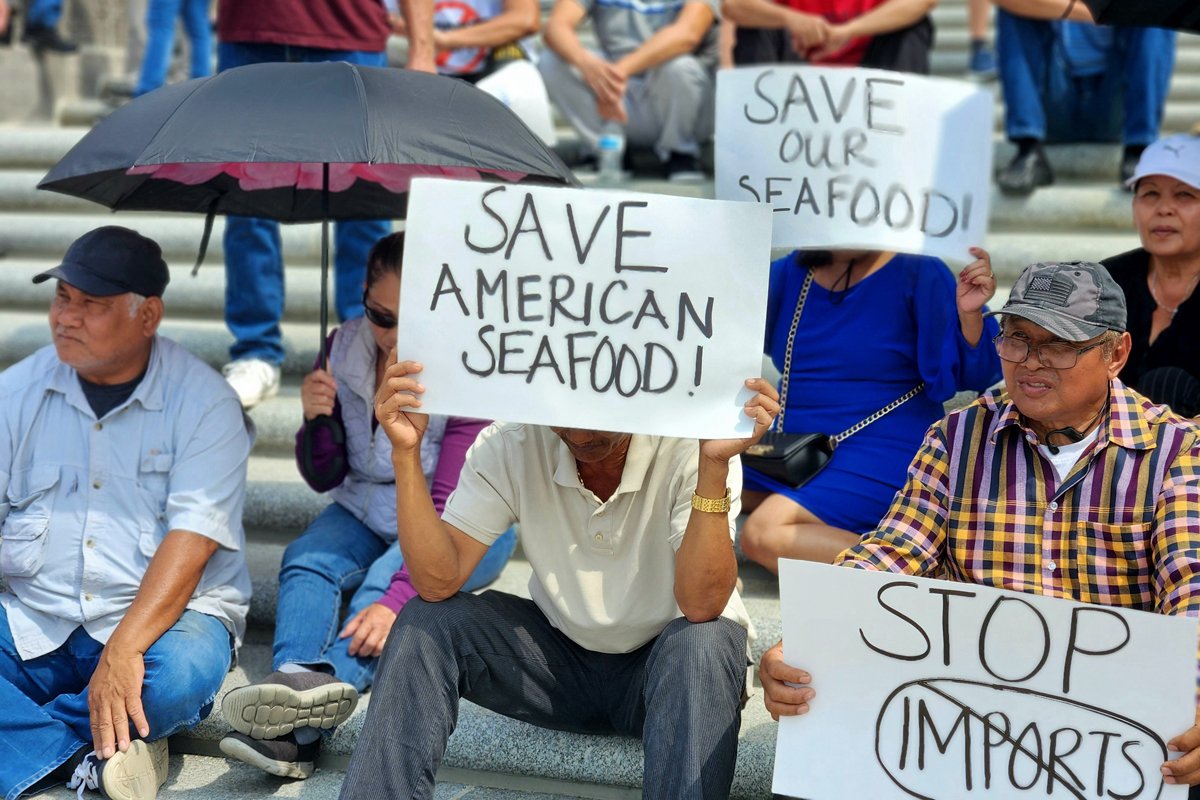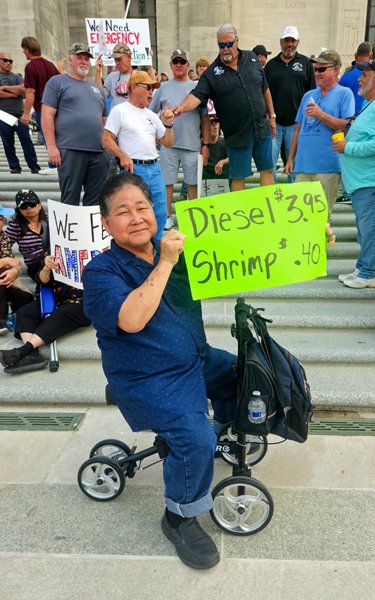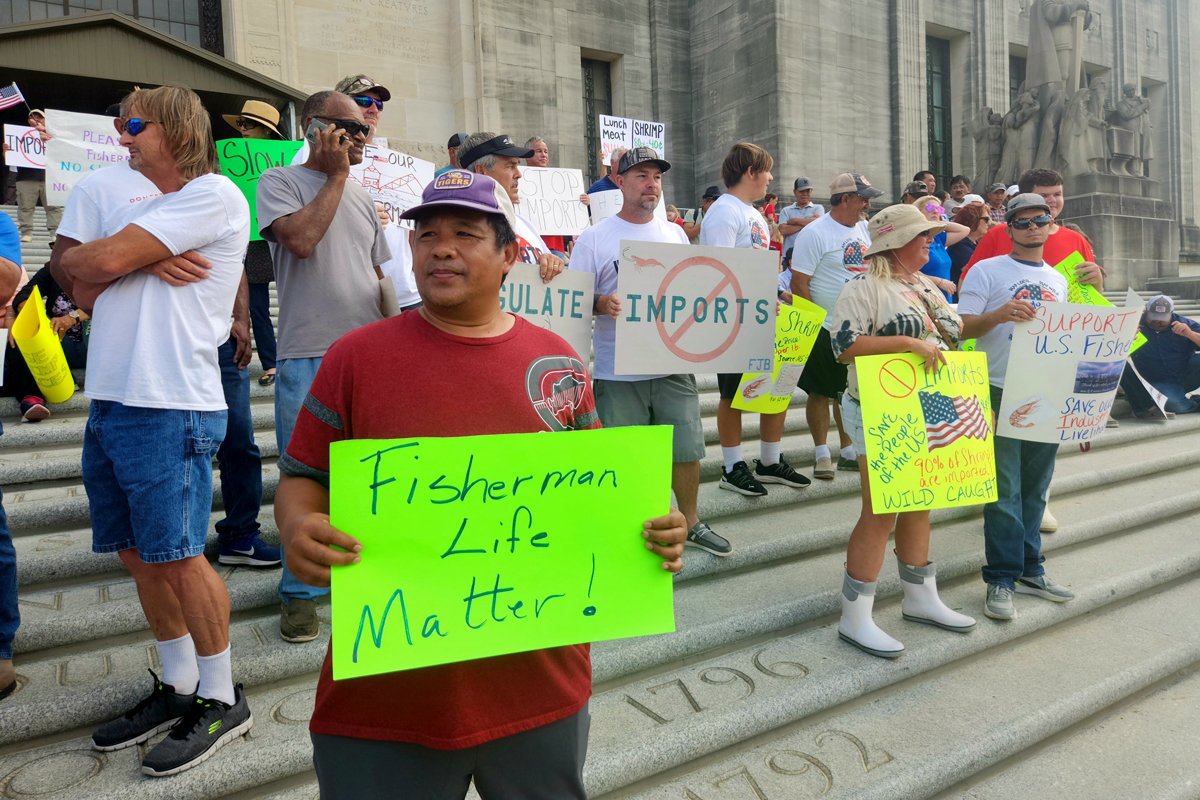Unable to compete with imports, Louisiana’s shrimpers are calling for emergency action to shore up their shrinking industry.

Unable to compete with imports, Louisiana’s shrimpers are calling for emergency action to shore up their shrinking industry.
June 20, 2023

Louisiana shrimp harvesters at a rally for higher pay per catch. (Photo credit: Grey Moran)
Update: On June 30, 2023, NOAA retroactively declared the 2020 hurricane season a disaster. State lawmakers called the declaration, “another step toward some federal financial assistance to Louisiana’s fishing community.”
“We are paying to work. We are paying to feed our nation,” said Kindra Arnesen, at a rally on the steps of Louisiana’s towering capitol in mid-May. “I ask for immediate emergency action at all levels. Nothing else will be accepted by this group.”
The 45 year-old shrimp harvester—who has been hailed as a voice for the Gulf, and has fought for decades to sustain the domestic shrimp industry—was surrounded by nearly a hundred other harvesters who had traveled inland from their homes along coastal Louisiana to Baton Rouge to rally for livable shrimp prices.
“When [shrimpers] say that they are working for starvation wages, they are not lying.”
It was a warm, clear-skied day, perfect weather for trawling. But the shrimpers chose to join Arnesen and shut down their businesses for the day to rally against the precipitous drop in the price for their catch. Shrimpers who harvest from the Gulf of Mexico have seen dockside shrimp prices—the first step in the wild-caught shrimp supply chain—fall to the lowest numbers since 2019. According to preliminary 2023 data from the National Marine Fisheries Service, shrimp prices have dropped by as much as 44 percent since 2022. For instance, the price of medium-large, unprocessed Gulf Coast shrimp fell from $2.79 per pound to $1.54.
But some Louisiana shrimpers are netting even lower prices. The shrimpers at the rally—who all operate as independent businesses owners—provided Civil Eats with eight pricing sheets for Louisiana docks in April, May, and June. The prices fell as low as 80 cents per pound for unprocessed, medium-large shrimp, while dropping to a mere 40 cents per pound for the tiny, popcorn-sized shrimp. While these figures shouldn’t be generalized for all of Louisiana, it confirmed that some shrimpers at the rally were fighting prices even lower than the preliminary federal data.

Ronald Johnston, a 64-year-old shrimp harvester, protests the low prices being paid for Gulf shrimp. (Photo credit: Grey Moran)
“Nobody can make money,” said Ronald Johnston, a 64-year-old shrimper who came to the U.S. in 1981 as a Vietnamese refugee. At the rally he held a lime-green poster that read: “Shrimp: $.40 cents. Diesel: $3.95” while sitting on a scooter that helps with his mobility. In an interview, Johnston recounted a recent four-day shrimping trip that cost $2,700 in diesel, and only resulted in $2,300 in sales. “I lose $400,” he said. “We cannot work for nothing.”
The current prices are a flashpoint in the decades-long price decline for domestic shrimp harvesters. As shrimp farms in Asia have grown to dominant the global industry over the last two decades, and the U.S. has ramped up shrimp imports, the price of U.S. shrimp has barely budged, reflecting a steep decline when considering inflation.
But this year’s drop in dockside prices, compounded with increases in the cost of living, dealt the industry a fresh blow—one that shrimpers fear they won’t recover from without government intervention to curb imports or shore up the domestic shrimp industry. In Louisiana, shrimpers are pushing for greater enforcement of an existing law requiring that restaurants specify whether the shrimp served is imported or domestic, hoping to drive up domestic sales.
Like Johnston, many shrimpers at the recent rally described losing money, or making just enough to cover the rising costs of operating their businesses. Economic simulations developed by Benedict Posadas, a seafood economist at Mississippi State University Extension, have found that when diesel costs $4 per gallon, shrimpers begin losing money when average shrimp prices fall below $4.50 per pound for headless shrimp—or the equivalent of $2.83 for unprocessed shrimp.
“When [shrimpers] say that they are working for starvation wages, they are not lying,” said Posadas.
The shrimpers at the rally largely hailed from Cajun, Vietnamese, and Cambodian communities, who have built stilted homes and shrimp fleets along the bayous, relying for generations on shrimping to make a living with businesses passed down between generations. But the future of this industry and way of life is in danger. The shrimp harvesters at the rally included many senior citizens, reflective of the industry: In 2018, half of Louisiana’s shrimpers were 54 or older. After shrimping most of their lives, the elderly workers still face the riptides of economic precarity.

Lanvin LeBlanc, a 65-year-old shrimp harvester, rallies for emergency action to shore up the domestic shrimping industry. (Photo credit: Grey Moran)
“I’ve reached a point in my life where I should be secure. I never did live a rich life but lived comfortable. You can’t do that no more,” said Lanvin LeBlanc, a 65-year-old Cajun shrimp harvester in a recent interview. LeBlanc fears that his age and ailing health make him unemployable elsewhere.
“I have never seen nothing like [these low prices] in my life, never did dream of anything like this to happen,” said LeBlanc in a speech in Baton Rouge in May. “All we ask is to be treated fair at the docks.”
Before the rally, the shrimpers were considering going on strike, tying up their shrimping vessels. But Acy Cooper, a 63-year-old Cajun shrimper and the president of the Louisiana Shrimp Association, feared this could risk pushing the teetering independent businesses over the edge. “If we go on strike, we’re only going to hurt ourselves,” he said. “If a guy’s hungry and needs to pay his bills, I’m not going to tell him he can’t.”
The economic power of a strike would also likely be diffuse, given that the shrimpers are not actual employees of any part in the supply chain. They sell their catch to the docks, before it is hauled off to processors, wholesale distributers, and finally the myriad of consumer retailers such as grocery stores and restaurants. The shrimpers don’t blame the docks for the low prices but the larger pressures that make their way down the chain, due to the influx of imports.
Unlike farmers, shrimpers have nothing equivalent to the farm bill, a safety net designed to protect some in agricultural industry. Even when crops fail, commodity farmers are often guaranteed an income via subsidized crop insurance. But the fishing industry operates fully at the whims of a global market, and when prices are low, the shrimping industry sinks.
Although the shrimpers are fighting to change this dynamic, they don’t have a shared policy platform. In Baton Rouge, Kindra Arnesen called upon them to unify their demands. “We got to start moving as one. We got to start voting as one. Build one solid block. Build one house,” she told the crowd, her voice reaching a crescendo. “If the roof is broke on a house but it’s still standing . . . we are from coastal communities. When it breaks, we [re]build it.”
The low dock prices have caused some shrimpers to tie up their vessels out of necessity.
“It’s not worth it,” said 57-year-old Chan Theun In, who lives in the coastal town of Buras, home to his Cambodian shrimping community. “I’ve tried going out [shrimping] so many times.” But he ends up turning around, realizing that he is trawling for nearly nothing. “All the Cambodian, Vietnamese people—they are docking their boats,” added In.

Chan Theun In, a 57-year-old shrimp harvester, on the steps of Louisiana’s Capitol in Baton Rouge. (Photo credit: Grey Moran)
“I can’t go out for these prices,” echoed Danny Smith, a 51-year-old, third-generation shrimper from St. Bernard Parish. “We’d have to catch millions of pounds to survive with these shrimp prices.” His wife, who has a “land job” as a legal assistant, is currently the family’s primary source of income. “If it wasn’t for her working, my house would be in foreclosure right now. I’d be filing bankruptcy,” he said.
Smith lost an arm while harvesting shrimp in 2008, when his sleeve got caught in the winch hauling in the nets. This has also put a strain on the operation, requiring him to hire a deckhand. “It’s hard to get good help because you can’t pay,” he said. Smith has been only able to minimally maintain his boat this season, which increases the risk of it breaking down and causing more injury. As it stands, fishing is one of the most hazardous jobs in the U.S.
This indefinite shuttering of shrimping businesses is part of the decades-long erosion of the industry. No longer a viable industry for many, the northern Gulf Coast shrimp industry lost just under half of its licensed shrimp harvesters between 2000 and 2020. Louisiana, still the largest shrimp producer in the U.S., had over 10,000 licensed commercial shrimpers in 2000. By 2020, over the span of just 20 years, that number dropped to just 4,300.
The shedding of U.S. shrimp workers has coincided with the drop in dockside prices due to imports from Asia and South America, said sociologist Jill Ann Harrison.
“Up until 2001, business hummed along as usual for shrimpers,” Harrison wrote in Buoyancy on the Bayou, an account of the Louisiana shrimp industry’s decline due to globalization. Then came the “pink tsunami,” as some call it: The rise of aquaculture technology helped spur an “extraordinary increase in the amount of farm-raised foreign imports into the U.S. seafood market,” she wrote. Between 2000 and 2004, shrimp imports surged by 71 percent from Brazil, China, Ecuador, India, Thailand, and Vietnam.
Domestic shrimpers still struggle to compete with the cheap imports, which were found in some cases to have been “dumped” or exported at prices below market value in their home country, illegally flooding the U.S. market. This tipped the scales even more toward imported shrimp. Dockside prices dropped. The U.S. imposed anti-dumping tariffs, currently under review. Yet illegal, unregulated seafood still proliferates in the U.S. consumer market. Last October, federal agencies released a joint strategy to curb the problem, linking it to the “collapse or decline of fisheries.”
Not only do illegal imports drive down domestic shrimp prices, but they also have consequences abroad, linked to ecological and human rights violations, including pollution, slavery in the shrimp industry, and the destruction of mangroves to make way for massive aquaculture operations. By comparison, the U.S. fishing industry has some of the strictest regulations in the world for ecological health and worker safety, yet these higher standards aren’t enough to drive up prices for shrimpers.
As domestic shrimpers flounder, U.S. consumers cannot get enough of the crustacean in question. Shrimp has soared to record-levels of popularity, in part because it’s no longer a regional or luxury food. The tide of cheaper imports helped mainstream shrimp, giving it versatility. It’s fast food. It’s an hors d’oeuvre. It’s fried festival food. It’s a cultural staple, an American tradition. It’s the biggest seafood import in the U.S, yet still celebrated as a “lifeblood” in Louisiana.
The sparse, even misleading labeling of U.S. shrimp, as sold in grocery stores and restaurants, often doesn’t make it possible to learn who harvested the shrimp, its country of origin, and whether it was caught or farmed. While fraudulent labeling remains an issue, even the legal labeling of shrimp can leave customers confused about its origins.
For instance, “Gulf shrimp” is commonly spotted in restaurants in New Orleans and around the U.S. However, this term isn’t certified or regulated, meaning that it lacks any real meaning. “That is a generic term that does not refer to the Gulf of Mexico per se,” said Deborah Long, of the Southern Shrimp Alliance. “It doesn’t add any definition to shrimp.” No matter the origin, any shrimp can be legally called “Gulf shrimp” as a descriptive term.
Similarly, “Louisiana shrimp” doesn’t necessarily refer to shrimp caught by Louisiana shrimpers. “That might mean that it is prepared in a Cajun style,” said Long. Grocery stores are required by federal law to include the country of origin, but packaged shrimp still often employs similar misleading marketing.
This murky labeling can also come with health consequences for consumers. The U.S. Food and Drug Administration every year rejects imported shrimp that tests positive for antibiotics and veterinary residues. The most recent example occurred in April. Yet the vast majority—98 percent of imported seafood—does not receive any testing for contamination before entering the U.S. market.
In 2019, Louisiana passed a law requiring restaurants to include the country of origin of shrimp on menus. However, shrimpers claim the law lacks meaningful enforcement.
No matter the origin, any shrimp can be legally called “Gulf shrimp” as a descriptive term.
Another bill was recently introduced to increase the penalties for violating the law, yet it was deferred by Louisiana’s House of Natural Resources and Environment Committee. That caused a controversy that came to a head at the May rally as State Representative Ryan Bourriaque, a Republican and vice president of the committee, concluded his speech promising to support the shrimp harvesters.
As he was leaving the podium, shrimper Kim Chauvin interjected. “Hold up. Hold up. Why didn’t we have your support for that labeling law? I was there. I was in that seat,” she said, referring to an April hearing, where she testified in favor of strengthening the labeling law.
“I think [the bill] should come back. Bring it back,” said Bourriaque, as shrimp harvesters whooped and applauded at his promise. Then, in early June, he voted in favor of resolutions to urge federal and state agencies to expand testing of imported shrimp, but the labeling law was not revisited in the legislative session.
Chauvin also questioned State Representative Clay Schexnayder, a Republican and Speaker of the House, and Senator Patrick Connick on the labeling law. Schexnayder assured her that the House would “take a look” at the bill, vowing that the lawmaking body will “stand with the shrimpers of Louisiana to get this right.” Likewise, Connick, a Republican, told the shrimpers that he understands their “plight,” promising to “resurrect [the bill] next year for sure.”
Some local politicians, including Connick, have called for a quota or ban on imported shrimp, and many shrimpers were waving signs at the rally that included a “🚫” symbol drawn over the word imports. However, under the existing World Trade Organization (WTO) framework, governments are barred from imposing quotas for economic reasons, less they risk retaliation and a dispute in international court.
“If you want to impose a quota, you have to have some sort of policy rationale,” said Petros Mavroidis, a former member of the WTO’s legal division who now teaches trade law at Columbia Law School. He added that the U.S. would need to make a case for imposing quotas based on concerns such as health hazards or fish stock populations.
However, Mavroidis points to the possibility of a temporary quota. It’s a measure that would be “blatantly illegal” but take a while to dispute, given that there is currently no appellate body to arbitrate a WTO case. “It’s in abeyance because President Trump refused to renew the mandate of the appellate body judges,” he said. In theory, the U.S. could pursue a quota during this waiting period.
As Mavroidis sees it, the most feasible, law-abiding route is to expand the testing of imported shrimp, indirectly curbing imports. “That’s very legitimate. Especially when you suspect that something goes wrong in the foreign market, you can always test on sanitary grounds,” he said. “That’s the way to go forward.”

Acy Cooper, a shrimp harvester and the president of the Louisiana Shrimp Association, speaks at a rally in Baton Rouge. (Photo credit: Grey Moran)
The shrimp harvesters have been searching for ways to adapt their businesses to this turbulent season. Finding the dock prices too low, some have pivoted to selling shrimp for higher prices directly to individuals, restaurants, and fish markets. However, this comes with drawbacks: The shrimp is sold in smaller quantities, and the shrimpers need to establish their own retail markets. Plus, consumers are mainly interested in large shrimp, which can be hard to come by.
“Our job is to go catch them. So now you’re making me a wholesale dealer when I really don’t want to be [one],” said Acy Cooper, who lives and harvests shrimp near the mouth of the Mississippi River. He has reluctantly moved to selling shrimp for $3 or $4 per pound directly to neighbors and restaurants. Cooper’s sparse advertising is the language of a straight shooter: “For fresh shrimp, call me.”
In the same boat, Yancy Tucker, a 63-year-old shrimper, has moved to a strategy of selling just enough of his catch to the docks to cover his expenses. “I still sell [at the docks] to pay for my ice and my fuel, whatever I can get,” Tucker said, in his Cajun accent. The remaining shrimp is then sold to neighbors and restaurants for a higher price, personally delivered in his truck when it’s a large order. So far, his customer base is all local, built by word-of-mouth.
Seeing the writing on the wall, 55-year-old Kim Chauvin took business classes to learn how to sell her shrimp directly to customers and retailers. It has been useful this year as she has pivoted to selling shrimp at farmers’ markets on the weekends. She has developed specialty products, including shrimp patties, gumbo, and shrimp tossed in pasta with alfredo sauce, that she sells alongside fresh and frozen shrimp. She also sells to seafood markets, restaurants, and bait shops. But it’s still not enough.
All the shrimpers we spoke to are relying on these kinds of strategies to stay afloat, but just barely. They’re trying to hold on—to a family industry, a way of life, and a driver of rural economies.
“When you lose the thing that was the economic engine, you lose a hell of a lot,” said Chauvin. “Everything else begins to die off.” She lists shrimping towns that have become near ghost towns as they’ve lost processors, ice houses, and grocery stores. Just two weeks after the rally, the port town of Delcambre, known as a Louisiana’s shrimping hub, lost a processor and its only ice house.
“I’m doing the best I can. I’m just trying to survive,” said Chauvin. It’s a refrain she has grown tired of repeating over the years, as one of the last largely family-run industries slowly disappears. “In all reality, I’m just trying to survive.”
Note on shrimp prices: For the sake of consistency, this article only uses the prices of unprocessed shrimp. The data from the National Marine Fisheries Service (NMFS) reflects headless shrimp, which is more expensive than unprocessed shrimp. NMFS uses a conversion factor (.629 for the Gulf of Mexico) to convert the price of headless shrimp to its equivalent price as unprocessed shrimp. Moran applied this same conversion factor to NMFS’s data in order to have comparable prices.

September 4, 2024
By paying top dollar for milk and sourcing within 15 miles of its creamery, Jasper Hill supports an entire community.
September 3, 2024

August 27, 2024

August 26, 2024

Like the story?
Join the conversation.